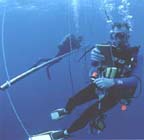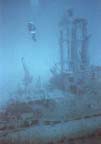
(Click for full sized image 29K)
Great News!
After decades of being off-limits to all but a few research expeditions, beginning in the Summer of 1996, divers are now able to dive the incredible wrecks of Bikini Atoll with Marshalls Dive Adventures!
CEN PAC is the original representative for Bikini diving in the US. We have more satisfied clients and provide more personalized service than anyone!
BIKINI ATOLL is the final resting place of some of the most significant warships in history.
The U.S. aircraft carrier Saratoga (the only divable carrier in the world) and the HIJMS Nagato, flagship of the Japanese Navy, are the highlights of this site.
Along with other ships such as the battleship Arkansas and the submarine Pilotfish, nearby reefs that have not been impacted by civilization for 40 years and are teeming with all types of fish and corals, round out this incredibly unique experience.
The "land only" price is $2,750. For your convenience, CEN PAC can provide all air transportation at competitive rates. We also arrange add-ons to other islands in the Marshalls or Micronesian destinations such as Truk (Chuuk), Palau, Yap, Pohnpei, or Kosrae.
We strongly encourage you to visit some of the these other destinations since you will be "in the neighborhood."
Airfare from HNL to BIK is $1,170. Rates to HNL vary. From the U.S. West Coast to Honolulu is about $350, and from the East Coast the fare is about $625. For those of you outside the U.S., please call for a firm quote.
We are currently taking reservations for excursions from April 15 through November 15. Since we made our original announcement, our weeks are filling up fast.
In order to assure you don't miss out on this opportunity, you should immediately call, fax, or fill out our on-line Information Request Form and indicate which week you would like to go and the number of travelers in your party.
